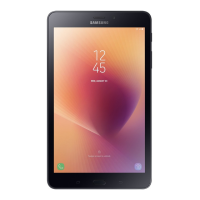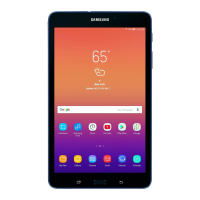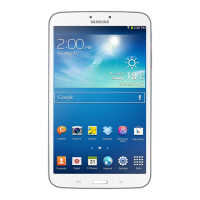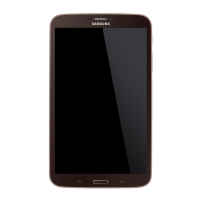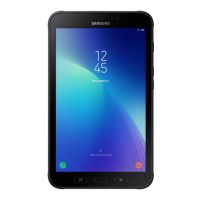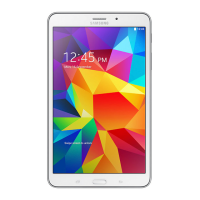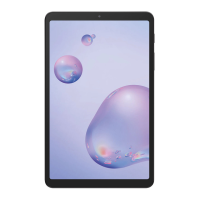Do you have a question about the Samsung SM-T385 and is the answer not in the manual?
Important safety and usage information to read before using the device.
Explains why the device may heat up and how to address the issue.
Details the physical layout and key components of the device.
Information on charging the device's battery and managing consumption.
Instructions for installing and removing the SIM or USIM card.
Guide to installing and managing memory cards for expanded storage.
Procedures for powering the device on, off, and restarting it.
Step-by-step guide for setting up the device after purchase or reset.
Explains how to register, use, and manage a Samsung account for device services.
Methods for transferring data from an old device to the new one.
Explains how to control the touchscreen and basic gestures.
Overview of the device's Home screen and Apps screen layout.
Explains the meaning of icons displayed on the status bar.
Details on locking and unlocking the device, and changing lock methods.
How to take screenshots using different methods on the device.
Information on the keyboard layout, changing languages, and text input.
Steps to download, install, and remove applications from the device.
Introduction to Bixby Home and how to start using it.
Guide to making and receiving voice and video calls.
Instructions for adding, importing, and managing contacts.
How to send, view, and manage text messages.
Browsing the web, managing tabs, and using secret mode.
Setting up, sending, and reading emails on the device.
Instructions for taking photos and recording videos with the device.
Viewing and managing photos and videos stored on the device.
How to use split screen and pop-up view for multitasking.
Creating and managing notes, including text, drawings, and voice recordings.
Managing your schedule by creating and organizing events and tasks.
Connecting your tablet to your smartphone for content sharing.
Accessing and managing files and folders stored on the device.
Setting alarms, using the world clock, stopwatch, and timer.
Performing calculations and using the unit conversion tool.
Organizing and launching games, and managing performance modes.
Options for sharing images and other content via various methods.
Overview of pre-installed Google applications like Chrome, Gmail, and Maps.
Configuring network connections like Wi-Fi and Bluetooth.
Activating Wi-Fi and connecting to networks.
Pairing and managing Bluetooth devices for data exchange.
Sharing the device's mobile data connection as a hotspot or via tethering.
Adjusting sound modes, ringtones, notification sounds, and vibration settings.
Managing notification settings for individual apps and lock screen display.
Adjusting screen brightness, outdoor mode, blue light filter, and font settings.
Activating and configuring various advanced device functionalities.
Overview of battery, storage, memory, and security status; quick optimization.
Managing device apps, including notifications, permissions, and uninstallation.
Securing the device with screen lock types, smart lock, and other security options.
Creating and using a secure folder for private content and apps.
Syncing, backing up, and restoring data using cloud services and managing accounts.
Setting up and managing additional user accounts for shared device use.
Backing up and restoring personal information, app data, and settings.
Customizing settings to improve device accessibility for various user needs.
Customizing system settings like language, date/time, and reset options.
Updating the device's software and security patches.
Accessing device information such as phone number, model, and software version.
Solutions for common device issues like lock codes, network errors, and power problems.
Solutions for touchscreen responsiveness problems and device freezing.
Resolving problems with calls not connecting, poor audio quality, and network disconnections.
Addressing battery depletion, camera error messages, and photo quality problems.
Important safety and usage information to read before using the device.
Explains why the device may heat up and how to address the issue.
Details the physical layout and key components of the device.
Information on charging the device's battery and managing consumption.
Instructions for installing and removing the SIM or USIM card.
Guide to installing and managing memory cards for expanded storage.
Procedures for powering the device on, off, and restarting it.
Step-by-step guide for setting up the device after purchase or reset.
Explains how to register, use, and manage a Samsung account for device services.
Methods for transferring data from an old device to the new one.
Explains how to control the touchscreen and basic gestures.
Overview of the device's Home screen and Apps screen layout.
Explains the meaning of icons displayed on the status bar.
Details on locking and unlocking the device, and changing lock methods.
How to take screenshots using different methods on the device.
Information on the keyboard layout, changing languages, and text input.
Steps to download, install, and remove applications from the device.
Introduction to Bixby Home and how to start using it.
Guide to making and receiving voice and video calls.
Instructions for adding, importing, and managing contacts.
How to send, view, and manage text messages.
Browsing the web, managing tabs, and using secret mode.
Setting up, sending, and reading emails on the device.
Instructions for taking photos and recording videos with the device.
Viewing and managing photos and videos stored on the device.
How to use split screen and pop-up view for multitasking.
Creating and managing notes, including text, drawings, and voice recordings.
Managing your schedule by creating and organizing events and tasks.
Connecting your tablet to your smartphone for content sharing.
Accessing and managing files and folders stored on the device.
Setting alarms, using the world clock, stopwatch, and timer.
Performing calculations and using the unit conversion tool.
Organizing and launching games, and managing performance modes.
Options for sharing images and other content via various methods.
Overview of pre-installed Google applications like Chrome, Gmail, and Maps.
Configuring network connections like Wi-Fi and Bluetooth.
Activating Wi-Fi and connecting to networks.
Pairing and managing Bluetooth devices for data exchange.
Sharing the device's mobile data connection as a hotspot or via tethering.
Adjusting sound modes, ringtones, notification sounds, and vibration settings.
Managing notification settings for individual apps and lock screen display.
Adjusting screen brightness, outdoor mode, blue light filter, and font settings.
Activating and configuring various advanced device functionalities.
Overview of battery, storage, memory, and security status; quick optimization.
Managing device apps, including notifications, permissions, and uninstallation.
Securing the device with screen lock types, smart lock, and other security options.
Creating and using a secure folder for private content and apps.
Syncing, backing up, and restoring data using cloud services and managing accounts.
Setting up and managing additional user accounts for shared device use.
Backing up and restoring personal information, app data, and settings.
Customizing settings to improve device accessibility for various user needs.
Customizing system settings like language, date/time, and reset options.
Updating the device's software and security patches.
Accessing device information such as phone number, model, and software version.
Solutions for common device issues like lock codes, network errors, and power problems.
Solutions for touchscreen responsiveness problems and device freezing.
Resolving problems with calls not connecting, poor audio quality, and network disconnections.
Addressing battery depletion, camera error messages, and photo quality problems.
| Model | SM-T385 |
|---|---|
| Category | Tablet |
| Display Size | 8.0 inches |
| Display Resolution | 800 x 1280 pixels |
| Display Type | TFT |
| OS | Android 7.1 (Nougat) |
| Chipset | Qualcomm MSM8917 Snapdragon 425 |
| CPU | Quad-core 1.4 GHz Cortex-A53 |
| GPU | Adreno 308 |
| RAM | 2 GB |
| Internal Storage | 16 GB |
| Expandable Storage | microSDXC (dedicated slot) |
| Main Camera | 8 MP, AF |
| Front Camera | 5 MP |
| Wi-Fi | Wi-Fi 802.11 a/b/g/n, dual-band, Wi-Fi Direct, hotspot |
| Bluetooth | 4.2, A2DP, LE |
| GPS | Yes, with A-GPS, GLONASS, BDS |
| Colors | Black, Gold |
| Battery | 5000 mAh |
| Dimensions | 212.1 x 124.1 x 8.9 mm |
| SIM | Single SIM (Nano-SIM) |
| Weight | 364 g |
